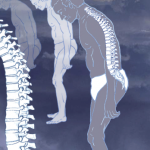Although much further study of male-female differences in axSpA is indicated, it seems reasonable that reports of clinical studies should provide separate results on the basis of both HLA-B27 positivity and sex. Such an approach would be consistent with progress to personalized medicine which will be based on a host of biomarkers whose number will only increase in the future. Analysis of the impact of male-female differences seem an easy way to start.
A Uterine-Joint Axis
Abstract 1708: Mauro et al.4
This study combines three exciting areas of interest in rheumatology: male-female differences in disease manifestations; the role of the microbiome in immunopathogenesis; and the use of gene-expression analysis to elucidate underlying disease mechanisms.
Extending ideas on the gut-joint axis in the pathogenesis of axSpA, Mauro et al. explored a uterine-joint axis by assessing the microbiota in vaginal, cervical and uterine swabs using 16 rRNA sequencing. The study found evidence of genital dysbiosis in axSpA patients. A reduction in Lactobaccilli and an increase in Gardnerella vaginalis were both observed. Further, single-cell RNA sequencing of menstrual blood from patients with axSpA showed a strong imbalance of monocytes and IL-7R positive cells compared with those of healthy controls.
A companion study in SKG mice also showed evidence of genital inflammation and specific gene clustering in genital tract tissues compared with those of control BALB/c mice.
Although this study involved only a small number of patients, the results are nevertheless provocative. They are a reminder that the gut represents only one microbiome and that the study of the uterine microbiome may provide essential data to elucidate male-female differences in inflammatory disease.
Vitamin D Supplementation
Abstract 0565: Lichaa et al.5
axSpA has gone by other names, including Bechterew’s disease, Marie-Strumpell disease and, of course, ankylosing spondylitis (AS). AS is, in fact, a misleading term because most patients don’t ankylose and, indeed, many do not show any radiographic findings. The study by Lichaa and colleagues investigates determinants of ankylosis based on imaging by an experienced radiologist, comparing those with ankylosis and those without matching for relevant factors. As a possible determinant for ankylosis, serum vitamin D levels were assessed after occurrence of ankylosis.
In the patient cohort studied, 16% had ankylosis and were more likely to have low vitamin levels compared to matched controls (18.63 vs 24.36 ng/ml). This finding is interesting although the mechanisms by which a low vitamin D level would affect bony ankylosing is speculative. Given the simplicity of vitamin D supplementation and possible other health benefits, a trial of vitamin D supplementation is certainly warranted, but likely difficult to conduct because of the length of the study and uncertainty in level of vitamin D that should be targeted. Nevertheless, it seems very reasonable to assess vitamin D levels as part of the evaluation of patients with axSpA and consider supplementation with the chance that it reduces the progression to AS.


